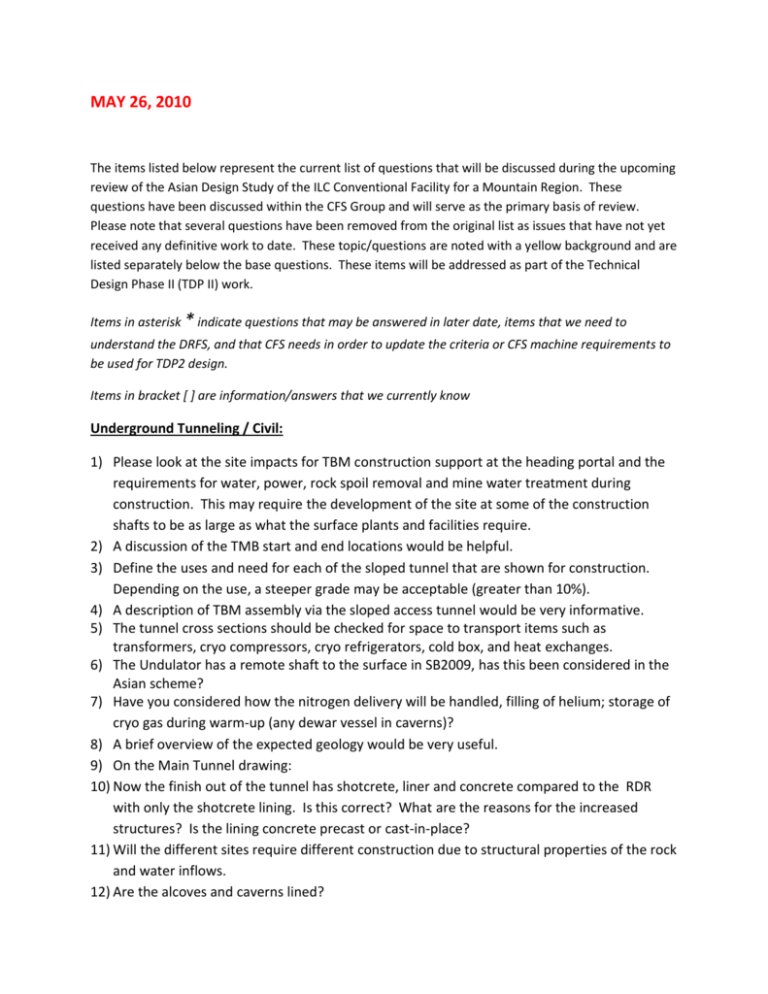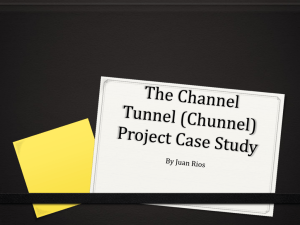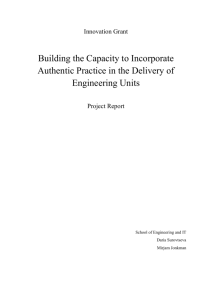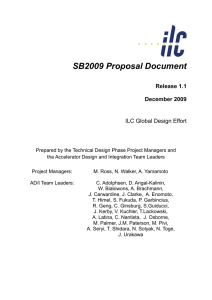Review_Questions
advertisement

MAY 26, 2010 The items listed below represent the current list of questions that will be discussed during the upcoming review of the Asian Design Study of the ILC Conventional Facility for a Mountain Region. These questions have been discussed within the CFS Group and will serve as the primary basis of review. Please note that several questions have been removed from the original list as issues that have not yet received any definitive work to date. These topic/questions are noted with a yellow background and are listed separately below the base questions. These items will be addressed as part of the Technical Design Phase II (TDP II) work. Items in asterisk * indicate questions that may be answered in later date, items that we need to understand the DRFS, and that CFS needs in order to update the criteria or CFS machine requirements to be used for TDP2 design. Items in bracket [ ] are information/answers that we currently know Underground Tunneling / Civil: 1) Please look at the site impacts for TBM construction support at the heading portal and the requirements for water, power, rock spoil removal and mine water treatment during construction. This may require the development of the site at some of the construction shafts to be as large as what the surface plants and facilities require. 2) A discussion of the TMB start and end locations would be helpful. 3) Define the uses and need for each of the sloped tunnel that are shown for construction. Depending on the use, a steeper grade may be acceptable (greater than 10%). 4) A description of TBM assembly via the sloped access tunnel would be very informative. 5) The tunnel cross sections should be checked for space to transport items such as transformers, cryo compressors, cryo refrigerators, cold box, and heat exchanges. 6) The Undulator has a remote shaft to the surface in SB2009, has this been considered in the Asian scheme? 7) Have you considered how the nitrogen delivery will be handled, filling of helium; storage of cryo gas during warm-up (any dewar vessel in caverns)? 8) A brief overview of the expected geology would be very useful. 9) On the Main Tunnel drawing: 10) Now the finish out of the tunnel has shotcrete, liner and concrete compared to the RDR with only the shotcrete lining. Is this correct? What are the reasons for the increased structures? Is the lining concrete precast or cast-in-place? 11) Will the different sites require different construction due to structural properties of the rock and water inflows. 12) Are the alcoves and caverns lined? 13) A discussion on TBM excavation schedule/ advancement rate and drive lengths would be useful. 14) Risk of water ingress/pressure for the different sites would be very interesting. For example, do any of the sites avoid risk of water ingress, and as such, could the drainage tunnel be cancelled? ie do any have the sites have low permeability rockmass and could high risk geological faults be avoided ? 15) If not and water is a risk at all of the sites : a) Is it possible to install a waterproof lining system for the main linac tunnel. This might be cheaper than a special drainage tunnel? b) Could the ground be treated to reduce permeability instead of drainage tunnel? eg advance grouting of the rockmass Questions from W. Bialowons: 1) My question is: what is the motivation for such a complicated tunnel design, are there comparable tunnel projects under construction or finished in Japan? Can we get information about these projects? 2) The background of the second question is that even a tunnel in granite is not absolute stable. The pressure of the rock deforms the caverns and tunnel especially if they are not cylindrically. 3) My second question is: what is movement of a cavern respectively hall floor per year? 4) The temperature increases underground with a rate of 3 Kelvin per 100 m. 5) My third question is: what is the temperature (profile) in the tunnel of the Asian sample site, how much heat dissipates from the tunnel walls and how much power is necessary to cool it? 6) For the cryo module production we are discussing very heavily the mass production benefit. 7) For the time being my last question is: can we get detailed information about the composition of the (relative) tunnel and underground construction cost like fixed cost linear and nonlinear cost? Electrical: 1) Please provide an overview of the AC power distribution. 2) What was the power used as basis? RDR or SB2009 or anything newer than SB2009? * 3) Is the primary power available at the 4 sites adequate and at roughly the same distance from the project site? Will the source for primary power enter at one or multiple shaft locations? 4) What are the design criteria for the electrical alcoves? How many RF units are planned to be supplied from each alcove, transformer size. We need to develop an electrical power table similar to the RDR for both the Klycluster and DRFS. We should discuss who the key contributors are and where the changes might be. The RDR table included RF, magnets, conventional, cooling, cryo and emergency. Fermilab can lead this. Life Safety: 1) What is your ventilation scheme with regard to life safety? Are you considering any areas of refuge? 2) While there are two tunnels that can be used for egress, the distance to the outside is substantial for some areas. Do you have any guidance for the distance between exits to the outside. 3) Is there any oil in the smaller klystrons? If so, what is the volume? Can we identify the fireload that will be in the tunnels. * 4) In the event of an unexpected Helium release (like LHC), have escape paths been considered for this new layout? 5) General Comment: I don’t think that Life Safety should be used as an argument for having a second tunnel because this contrary to what has been demonstrated as feasible in the other two regions. Mechanical: 1) What was the heat load used as basis? RDR or SB2009 or newer than SB2009? i) * [The heat load in RDR was about 182MW but it doesn’t include the heat rejection coming from cryo] 2) What is the size and area required of the surface plant for the heat rejection system at the end points and center point of the site? 3) Are the large water piping shown in the access tunnel, process water, chilled water or LCW? If its process water, will there be individual LCW skids every X RF similar to RDR? Where are those located? Are you using any chilled water for these racks? Or chilled water for other cooling requirement? i) [The RDR scheme used a process water main with LCW skids located in every 4 RF Units. It also used a separate chilled water system for the rack requirement. The post RDR- value engineering scheme, cost was reduced by providing just one LCW water system at every major shafts, that serves as heat rejection. The chilled water requirement by the rack was assumed to have a water cooled rack chiller in each RF that reject its heat to the LCW main] 4) What is your site wetbulb temperature? Is it similar to Illinois? i) [The Illinois site has a design wet bulb of 78F (25.5C), which allow for a 85F (30C) cooling tower outlet and 90F (32C) LCW water supply] 5) How are the cryoplant in the cavern to be cooled (compressors and heat to air)? What are the dimensions of the underground cryo cavern? i) [The previous RDR heat table didn’t include that cryo heat rejection. This was handled separately by the cryo tower system.] 6) Would the cryoplant in the cavern create vibration issues? Considering the beam are supported from the tunnel ceiling 7) (interface question)Where does the CFS water system end? In header with valve? 8) Have you accounted for the large ODH (oxygen deficiency hazard) Ventilations that the cryogenic will require? The following questions were taken from the original list, but separated because work remains to be completed for these topics. While these topics are important and work will need to be completed as part of the TDP II phase, these they will not be directly addressed in the upcoming review. Underground Tunneling / Civil: 1) Can you please describe the access to the damping rings. 2) Have you accounted for any survey shafts for alignment purposes. Electrical: 1) Is adequate space provided for transport of the electrical equipment through the tunnels? 2) How is the electrical power distribution routed in the tunnel? Is the power ducts in the invert slab or in tray? Life Safety: No Deferred Questions Mechanical: 1) Any work done on the water cooling scheme? a) What water system delta T, supply temperature and flow did they came up with or expected for their scheme? b) How are you cooling the ML multiple racks? Separate components or combined into one central location? c) What’s the load/delta T used for each water cooled component? OR are you just assuming similar to the RDR? d) In Post RDR scheme, each larger klystron has a small recirculation pump to accomplish the high water delta T (560 ML Klystron water recirc pumps Not Used), is this assumed the same in this scheme of smaller klystrons (7,280 ML Klystrons)? * i) [The RDR RF water delta started as an assumed 20F (11C) blended delta T and was increased to 45F (25C) delta T by series flowing, Load/circulator modification, recirculation pump at each klystron and reduction in rack heat load. The blended water system delta was about 33F (18C)] 2) What is the criteria and scheme for ventilation (size of duct?) 3) Are there individual dehumidifiers in the tunnel? Or the sub-tunnel? i) [The RDR for US site assumed a dehumidifier every ?? R ] 4) What is the criteria and scheme for ventilation (size of duct?) 5) Are there individual dehumidifiers in the tunnel? Or the sub-tunnel? i) [The RDR for US site assumed a dehumidifier every ?? R ] 6) Have you considered the loads in interaction region (IR)? * i) [In RDR, there were no IR load considered] 7) Have you considered what will be the space temperature? Humidity? Temperature stability? In the ML tunnel/Access tunnel/central region/Damping Ring for this Asian scheme? i) [We understood that the DR require a tight stability of 0.1 deg C] 8) Are you considering the temperature stability in the BDS? How are you accomplishing that? * i) [In the RDR, BDS has a requirement of very tight temperature stability of 0.5 deg C over 1 hour, 2 deg C over 24 hrs]








